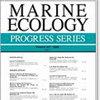奥特亚罗瓦/新西兰化合栖息地阿尔维诺卡氏虾的遗传连接性和同位素壁龛,以及一个新的阿尔维诺卡氏虾物种
IF 2.2
3区 环境科学与生态学
Q2 ECOLOGY
引用次数: 0
摘要
ABSTRACT: 新西兰奥特亚罗瓦近海的化合生态系统包括克马德克弧上的热液喷口和希库兰吉边缘的甲烷渗漏,这些地方栖息着丰富的特化动物群落,其中包括 4 种阿尔文卡氏虾。目前还没有利用基因工具对这些新西兰金眼鲷虾的系统位置进行研究,对它们的栖息地利用和摄食习性也知之甚少。在这里,我们利用基因条形码重新评估了新西兰金眼鲷虾的分类,并描述了它们在8个地点的连接性和同位素生态位。我们描述了一个新物种,Alvinocaris webberi sp.我们还发现 A. alexander 和 A. chelys 是 A. dissimilis 的初级同义词,揭示了从日本到新西兰的热液喷口和甲烷渗漏中的高度遗传连通性,大大扩展了其分布范围。最后,我们发现在共生的阿尔文卡氏虾中存在明显的生态位分离现象,这表明它们的食物和/或栖息地使用方式不同。尽管如此,所有物种都依赖化合资源,与栖息地深度无关,栖息地深度从380米到1650米不等。本文章由计算机程序翻译,如有差异,请以英文原文为准。
Genetic connectivity and isotopic niches of alvinocaridid shrimps from chemosynthetic habitats in Aotearoa/New Zealand, with a new Alvinocaris species
ABSTRACT: Chemosynthetic ecosystems off Aotearoa/New Zealand comprise both hydrothermal vents on the Kermadec Arc and methane seeps on the Hikurangi Margin which host rich communities of specialized fauna including 4 alvinocaridid shrimp species. The systematic positions of these New Zealand alvinocaridid shrimps have not been studied using genetic tools and little is known about their habitat use and feeding habits. Here, we re-evaluate the taxonomy of alvinocaridid shrimps from New Zealand using genetic barcoding and characterize their connectivity and isotopic niches across 8 localities. We describe a new species, Alvinocaris webberi sp. nov., previously confused with A. longirostris. We also show that A. alexander and A. chelys are junior synonyms of A. dissimilis, revealing a high genetic connectivity across hydrothermal vents and methane seeps from Japan to New Zealand, greatly extending its range. Finally, we find clear niche separation in co-occurring alvinocaridid shrimps, suggesting different diets and/or habitat use. Nevertheless, all species rely on chemosynthetic resources, regardless of the habitat depth, which ranges from 380 to 1650 m.
求助全文
通过发布文献求助,成功后即可免费获取论文全文。
去求助
来源期刊

Marine Ecology Progress Series
环境科学-海洋学
CiteScore
5.30
自引率
8.00%
发文量
238
审稿时长
3 months
期刊介绍:
The leading journal in its field, MEPS covers all aspects of marine ecology, fundamental and applied. Topics covered include microbiology, botany, zoology, ecosystem research, biological oceanography, ecological aspects of fisheries and aquaculture, pollution, environmental protection, conservation, and resource management.
 求助内容:
求助内容: 应助结果提醒方式:
应助结果提醒方式:


